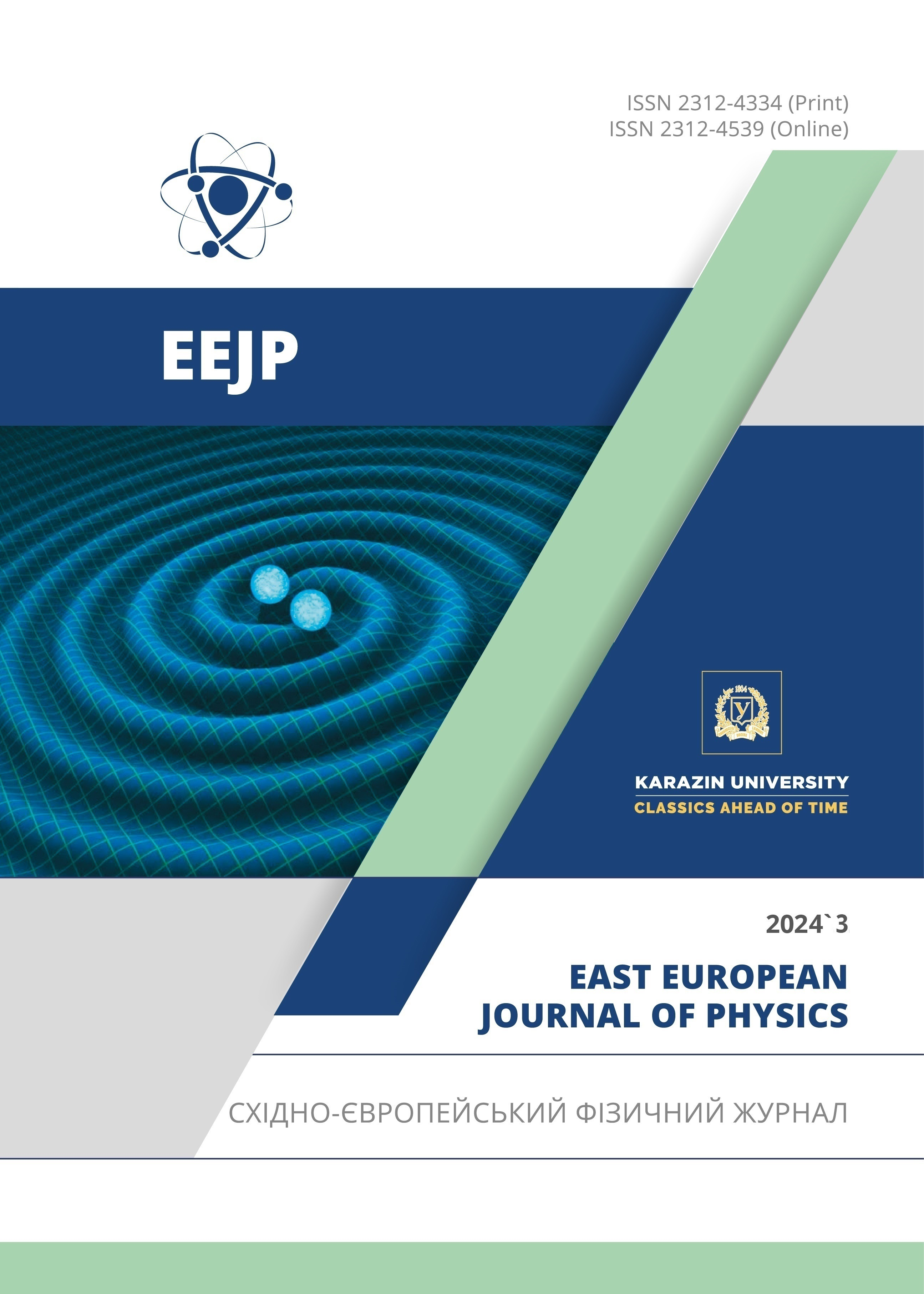High-Order B-Spline Finite Difference Approach for Schrodinger Equation in Quantum Mechanics
Abstract
This paper presents a new numerical method for solving the quantum mechanical complex-valued Schrodinger equation (CSE). The technique combines a second-order Crank-Nicolson scheme based on the finite element method (FEM) for temporal discretisation with nonic B-spline functions for spatial discretisation. This method is unconditionally stable with the help of Von-Neumann stability analysis. To verify our methodology, we examined an experiment utilising a range of error norms to compare experimental outcomes with analytical solutions. Our investigation verifies that the suggested approach works better than current methods, providing better accuracy and efficiency in quantum mechanical error analysis.
Downloads
References
M. Ahsan, I. Ahmad, M. Ahmad, and I. Hussian, “A numerical Haar wavelet-finite difference hybrid method for linear and non-linear Schrodinger equation,” Mathematics and Computers in Simulation, 165, 13-25 (2019). https://doi.org/10.1016/j.matcom.2019.02.011
M.A. Akbar, N.H.M. Ali, and R. Roy, “Closed-form solutions of two-time fractional nonlinear wave equations,” Results in Physics, 9, 1031-1039 (2018). https://doi.org/10.1016/j.rinp.2018.03.059
S. Arora, and I. Kaur, “Applications of quintic Hermite collocation with time discretisation to singularly perturbed problems,” Applied Mathematics and Computation, 316, 409-421 (2018). https://doi.org/10.1016/j.amc.2017.08.040
A. Başhan, “A mixed methods approach to Schrodinger equation: Finite difference method and quartic B-spline based differential quadrature method,” An International Journal of Optimization and Control: Theories & Applications, 9(2), 223-235 (2019). https://doi.org/10.11121/ijocta.01.2019.00709
L. Cheng, and Y. Zhang, “Breather-type solutions and rogue waves to a generalised (2++1)-dimensional nonlinear Schrodinger equation,” Pramana – J. Phys. 96, 52 (2022). https://doi.org/10.1007/s12043-022-02293-3
A. Esen, and O. Tasbozan, “Numerical solution of time-fractional Schrodinger equation by using quadratic B-spline finite elements,” In Annales Mathematicae Silesianae, 31(1), 83-98 (2017). https://eudml.org/doc/288345
D. Fyfe, “The use of cubic splines in the solution of two-point boundary value problems,” The computer journal, 12(2), 188-192 (1969). https://doi.org/10.1093/comjnl/12.2.188
A.R. Hadhoud, A.A. Rageh, and T. Radwan, “Computational solution of the time-fractional Schrodinger equation by using trigonometric B-spline collocation method,” Fractal and Fractional, 6(3), 127 (2022). https://doi.org/10.3390/fractalfract6030127
Q. Huang, C. Ruan, Z. Huang, and J. Huang, “Soliton solutions to a reverse-time non-local nonlinear Schrodinger differential equation,” Pramana – J. Phys. 97, 14 (2023). https://doi.org/10.1007/s12043-022-02491-z
A. Iqbal, N.N. Abd Hamid, and A.I.M. Ismail, “Cubic B-spline Galerkin method for numerical solution of the coupled nonlinear Schrodinger equation,” Mathematics and Computers in Simulation, 174, 32-44 (2020). https://doi.org/10.1016/j.matcom.2020.02.017
S.R. Jena, A. Senapati, and G.S. Gebremedhin, “Approximate solution of MRLW equation in B-spline environment,” Mathematical Sciences, 14(4), 345-357 (2020). https://doi.org/10.1007/s40096-020-00345-6
M.K. Kadalbajoo, and A. Awasthi, “Crank–Nicolson finite difference method based on a midpoint upwind scheme on a non-uniform mesh for time-dependent singularly perturbed convection-diffusion equations,” International Journal of Computer Mathematics, 85(5), 771-790 (2008). https://doi.org/10.1080/00207160701459672
S.R. Jena, and A. Senapati, “One-dimensional heat and advection-diffusion equation is based on improvised cubic B-spline collocation, the finite element method, and the Crank-Nicolson technique,” International Communications in Heat and Mass Transfer, 147, 106958 (2023). https://doi.org/10.1016/j.icheatmasstransfer.2023.106958
A. Khan, M. Ahsan, E. Bonyah, R. Jan, M. Nisar, A.H. Abdel-Aty, and I.S. Yahia, “Numerical Solution of Schrodinger Equation by Crank–Nicolson Method,” Mathematical Problems in Engineering, 2022, 991067 (2022). https://doi.org/10.1155/2022/6991067
A. Konguetsof, “A new two-step hybrid method for the numerical solution of the Schrodinger equation,” Journal of mathematical chemistry, 47(2), 871-890 (2010). https://doi.org/10.1007/s10910-009-9606-5
L. Lehtovaara, J. Toivanen, and J. Eloranta, “Solution of time-independent Schrodinger equation by the imaginary time propagation method,” Journal of Computational Physics, 221(1), 148-157 (2007). https://doi.org/10.1016/j.jcp.2006.06.006
T.R. Lucas, “Error bounds for interpolating cubic splines under various end conditions,” SIAM Journal on Numerical Analysis, 11(3), 569-584 (1974). https://doi.org/10.1137/0711049
M. Modanli, and F. Ozbag, “Stability of finite difference schemes for two-space dimensional telegraph equation,” Pramana – J. Phys. 96, 228 (2022). https://doi.org/10.1007/s12043-022-02474-0
Y.S. Ozkan, E. Yaşar, and A.R. Seadawy, “A third-order nonlinear Schrodinger equation: the exact solutions, group-invariant solutions and conservation laws,” Journal of Taibah University for Science, 14(1), 585-597 (2020). https://doi.org/10.1080/16583655.2020.1760513
J. Rana, and S. Liao, “On-time independent Schrodinger equations in quantum mechanics by the homotopy analysis method,” Theoretical and Applied Mechanics Letters, 9(6), 376-381 (2019). https://doi.org/10.1016/j.taml.2019.05.006
B. Saka, “A quintic B-spline finite-element method for solving the nonlinear Schrodinger equation,” Physics of Wave Phenomena, 20(2), 107-117 (2012). htp://doi.org/10.3103/s1541308x12020033
A. Senapati, and S.R. Jena, “Generalized Rosenau-RLW equation in B-spline scheme via BFRK approach,” Nonlinear Studies, 30(1), 73-85 (2023).
A. Senapati, and S.R. Jena, “A computational scheme for fifth-order boundary value problems,” International Journal of Information Technology, 14(3), 1397-1404 (2022). https://doi.org/10.1007/s41870-022-00871-7
D.Y. Shi, and H.J. Yang, “Superconvergence analysis of a new linearised MFEM for nonlinear Schrodinger equation,” International Journal of Computer Mathematics, 96(7), 1514–1531 (2018). https://doi.org/10.1080/00207160.2018.1527909
T.E. Simos, “A new Numerov-type method for the numerical solution of the Schrodinger equation,” Journal of mathematical chemistry, 46(3), 981-1007 (2009). https://doi.org/10.1007/s10910-009-9553-1
T.A. Sulaiman, A. Yusuf, and M. Alquran, “Dynamics of optical solitons and non-autonomous complex wave solutions to the nonlinear Schrodinger equation with variable coefficients,” Nonlinear Dynamics, 104, 639-648 (2021). https://doi.org/10.1007/s11071-021-06284-8
Copyright (c) 2024 Archana Senapati, Balaji Padhy, Shasikant Das

This work is licensed under a Creative Commons Attribution 4.0 International License.
Authors who publish with this journal agree to the following terms:
- Authors retain copyright and grant the journal right of first publication with the work simultaneously licensed under a Creative Commons Attribution License that allows others to share the work with an acknowledgment of the work's authorship and initial publication in this journal.
- Authors are able to enter into separate, additional contractual arrangements for the non-exclusive distribution of the journal's published version of the work (e.g., post it to an institutional repository or publish it in a book), with an acknowledgment of its initial publication in this journal.
- Authors are permitted and encouraged to post their work online (e.g., in institutional repositories or on their website) prior to and during the submission process, as it can lead to productive exchanges, as well as earlier and greater citation of published work (See The Effect of Open Access).








